Search tips
- To search in a subset of topics, select
 in the search field and select a filter.
in the search field and select a filter. - To search for a specific word or phrase, add quotation marks around it (example: "budget column") in the search field.
- To remove highlighting on the search terms in a topic, select
 .
. - To search within a topic, select
 , press Ctrl+F, and enter the search term.
, press Ctrl+F, and enter the search term.
Custom views
Set up custom views so you can see the relevant information at a glance. Your custom views are available automatically in all the projects that you have access to in the portfolio. You can also generate ad hoc reports from custom views.
- You can share your custom views with selected users or security roles if you have the related permission.
- If custom views include project-specific data, they won't work across projects.
You can create a custom view or save the current view when you change any of the following:
- Search filters
- Grouping option
- Sort order
- Columns (including order and width)
You can also add custom views as dashboard widgets for drawing sets, drawings, and most record types. If this feature is available for the view, the widget checkbox is displayed in the View Settings dialog.
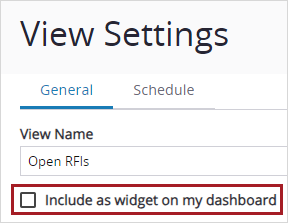
Dashboard widget checkbox
- In the View list, select the view.

You can save the settings in the current view as a new custom view.
- To modify the current view:
- In the Search panel, change the search filters.
- From the Group list, select an option.
- From the Sort list, select an option.
- In the list view, sort the items by column.
- Edit the columns in the view.
- Open the View list, and then select
(Add).
- Enter a unique name for the new view, and then select Save.
- Share the custom view.
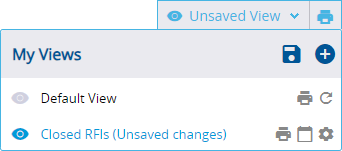
You can share your custom views with selected users or security roles if you have the related permission. The shared view displays the name of the person who created it.
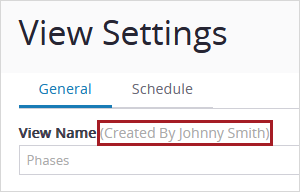
- In the View list, select
(Settings) by the custom data view.
- In the Permissions grid, select
(Add User).
- Select the checkbox for the users or roles, and then select Select.
- In the Permission column, select the permission for each user or role.
- Edit: Edit the permissions, search criteria, columns, grouping, and sorting of the shared custom view and add it as a personal dashboard widget. The user can save changes to the shared custom view.
- View: View the shared custom view and add it as a personal dashboard widget. If changes are made to the shared custom view, the user can save it as a new custom view.
- Select Save.
—Or—
Select (Add Role).
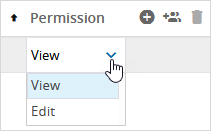
- In the View list, select
(Settings) by the custom data view.
- In the Search field, enter the name of the user or role, and select a search filter.
- In the Permissions list, select the checkbox for the users or roles that will be removed.
- Select
(Remove), and then select Delete.
- Select Save.

—Or—
To remove your own access to a view that was created by another user, select Delete.
You can edit the default view or a custom view.
- You create a custom view called New RFIs that shows RFIs with a status called New.
- When you apply the New RFIs view, the RFIs with the New status are displayed.
- You change the name of the status from New to Review.
- When you apply the New RFIs view, no RFIs with the Review status are displayed.
- In the Search panel, you turn on the Review toggle.
- In the View list, you save the changes to the New RFIs view.
- When you apply the New RFIs view again, the RFIs with the Review status are displayed.

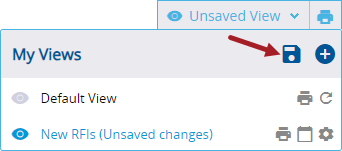
- In the View list, select the view.
- To modify the current view:
- In the Search panel, change the search filters.
- From the Group list, select an option.
- From the Sort list, select an option.
- In the list view, sort the items by column.
- Edit the columns in the view.
- Filter the list of portfolios.
- From the filter list at the top, select a filter.
- Owned by anyone: All portfolios that you have access to.
- Owned by me: Portfolios that you created.
- Not owned by me: Portfolios that are created by companies other than your own.
- In the search field at the top right, enter the search terms.
- Filter the list of projects.
- From the filter list at the top, select a filter.
- Owned by anyone: All projects that you have access to.
- Owned by me: Projects that you created.
- Not owned by me: Projects that are created by companies other than your own.
- In the search field at the top right, enter the search terms.
- Open the View list, and then select
(Save).

- In the View list, select
(Settings) by the custom data view.
- Select the Expand Groups by Default checkbox.
- Select Save.
- In the View list, select
(Settings) by the custom data view.
- In the View Name field, edit the name.
- Select Save.
You can edit the name if you created the custom view.
- In the View list, select
(Reset) by the default view.
- In the list, select Yes.
The standard settings are restored for the default view.
You can delete custom views but not the Default View.
Shared views can only be deleted by the user who created them.
- In the View list, select
(Settings) by the custom data view.
- In the View Settings dialog, select Delete.

